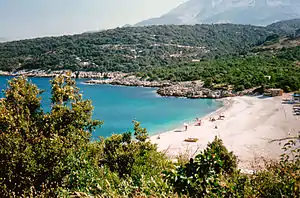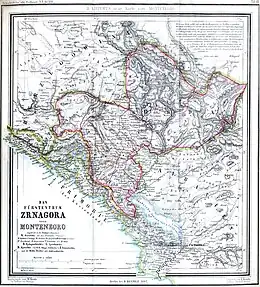
Mrkojevići (alternatively Mrkovići, in Montenergin Мркојевићи/Мрковићи, in Albanian Mërkot) is a historical tribal region in southwestern Montenegro, located between the towns of Bar and Ulcinj.[1] The region borders Krajina to the east. The Mrkojevići form a distinct ethno-geographical group with their own dialect of the Serbo-Croatian language, while also exhibiting a degree of bilingualism in Albanian. Their customs are distinct from their neighbouring Slavic and Albanian communities, but they also show influence and contacts with them. In the 400-year Ottoman period, the Mrkojevići converted to Islam, which forms an important aspect of their cultural identity.[1]
Geography
| Part of a series on |
| Tribes of Montenegro |
|---|
 |
The region is in the southern parts of Bar Municipality and forms one of its communal municipalities. There are nine settlements: Velje Selo, Dabezići, Dobra Voda, Gorana (Mala and Velja), Grdovići, Kunje, Ljeskovac, Pelinkovići and Pečurice. [1] The historical settlements of the tribal region also include Međreč and Mali/Velji Mikulici but as of 2011 they have no inhabitants. Mrkojevići is divided into pravi Mrkojevići (true Mrkojevići or Mrkojevići proper) that is closer the city of Bar and the Gorana sub-region to the south. Dobra Voda, Pečurice, Grdovići, Velje Selo, Dabezići, Ljeskovac, Međreč and Mali/Velji Mikulici belong to pravi Mrkojevići, while Mala/Velja Gorana, Kunje, Pelinkovići to the Gorana sub-region.
History
It is believed that the župa (county) of Prapratna was located in what became the Mrkojevići tribe.[2] Mrkojevići is first mentioned in 1409.
Johann Georg von Hahn recorded one of the first oral traditions about Mrkojevići from a Catholic priest named Gabriel in Shkodër in 1850. According to it the first direct male ancestor of the Mrkojevići was Merkota Keqi, son of the Catholic Albanian Keq , who, fleeing from Ottoman conquest, settled in a Slavic-speaking area that would become the historical Piperi region. His sons, the brothers Lazër Keqi (ancestor of Hoti), Ban Keqi (ancestor of Triepshi), Merkota Keqi, Kaster Keqi (ancestor of Krasniqi) and Vas Keqi (ancestor of Vasojevići) had to abandon the village after committing murder against the locals, but Keq and his younger son Piper Keqi remained there and Piper Keqi became the direct ancestor of the Piperi tribe.[3] Such stories exist in many tribes of northern Albania and southern Montenegro with different details every time in context with the general traditions of each tribe.
Comparative analysis of oral accounts and archival records shows that Mrkojevići is not a tribe of the same patrilineal ancestry, but a community of different ancestries that grouped and were linked to one another over time. Thus, as it is based on common territory and culture, but not kinship relations, it also intermarries within the tribe.
Mrkojevići's first group the pravi Mrkojevići formed the first nucleus, whose name eventually extended to the whole tribal region. In the defter of 1485 of the Sanjak of Scutari we have the first exact population records about Mrkojevići. It formed the nahiya of Merkodlar which is marked as one single settlement with 140 households.[4] In comparison to the demographic data of southern Montenegro and northern Albania whose settlements rarely had more than 100 households at the time, this settlement, which was probable spread around smaller clusters, was one of the biggest settlements in the borderlands of the Ottoman Empire and the Venetian coastal cities. The register of the household heads of pravi Mrkojevići shows that a majority of their names and patronyms were of Orthodox Slavic origin and a minority were Catholic Albanians. In the centuries that followed archival records indicate that they assimilated in the Orthodox majority.[5] Among the Albanians, names whose origin is traced to medieval tribes in the region like the Bukumiri can be found.[6][7] Slavic anthroponymy in Mrkojevići was frequently followed by the Albanian suffix -za. This phenomenon doesn't appear in such widespread form in any other area of Montenegro except for Crmnica to the north of Mrkojevići. It has been interpreted as the result of gradual, centuries-long adoption of Slavic culture by an Albanian-speaking population.[8] According to Curtis (2012), the Mrkojevići may present a case of an Albanian-speaking population shifting to a Slavic-speaking one.[9]
At the time of the defters compiling (1485), only one household had converted to Islam. Until 1571, the control of the region shifted frequently between Venice and the Ottomans. In the early 17th century the Mrkojevići were still Orthodox. Mariano Bolizza in his 1614 report notes that Marchoeuich has 260 households, 1,000 men-in-arms and is led by Maro Nikov. Settlements that became later part of pravi Mrkojevići are still recorded as separate like Dobra Voda with 100 men-in-arms under Rado Djurov. Gorana is still listed separately with 20 households and 45 men-in-arms under Dumo Luki.[10]
Today, only some families descend from pravi Mrkojevići, while all other brotherhoods and families are descendants of other families or progenitors that settled in the region after fleeing from other areas.[6] The majority of them originate from historic Albanian communities, which after arrival gradually shifted to being Slavic speaking, while a minority descend from Slavic speaking regions, mostly arriving from Old Montenegro.
Of these families: Ivanovići and Lakovići of Dobra Voda came from the Orthodox Slavic-speaking Kuči, Dapčevići came from Cetinje and Rackovići from Lješanska nahija after 1878 when it was annexed by Montenegro. Mujići, Maručići and Morstanovići in Mali Mikulići; Dabovići in Dobra Voda and Markići in Komina came from the Albanian-speaking region of Shestan and the Dibre brotherhood came from the region of Dibra (divided between Albania and Macedonia) around 1840. In Velja Gorana, the Osmanovići where formed in the 1930s when an Albanian from Katërkollë/Vladimir came to Velja Gorana when he married a woman from Vučići brotherhood, who themselves descend from Catholic Albanians who settled there in the late 19th/ early 20th century. The biggest brotherhood in the village, the Kovačevići trace their origin from two distinct families who settled in Velja Gorana in the second half of the 19th century. The first is that of Danila Kovačević, who escaped from a blood feud in the Montenegrin tribal region of Grahovo and settled in Mrkojevići where he became Muslim. The second family is that of Tahirovići who trace their origin to the village of Millë/Mide, in the Albanian geographical region of Ana e Malit in Ulcinj Municipality. In modern times, in Mrkojevići intermarriage takes place with the Slavic Muslim areas of Poda and Tudemili to the north and the Albanian Muslim areas to the south. As a result of different ethnic origins and also intermarriage, part of Mrkojevići is bilingual in Albanian and a local Serbo-Croatian dialect, which shows some influence by the neighbouring Gheg Albanian. This dialect, which retains characteristics of the dialect of Old Montenegro is also influenced by Ottoman Turkish and possibly Venetian. It is mainly spoken by the older generations, while the younger ones mostly speak standard Montenegrin (crnogorsko).[6]
After 1878, when Mrkojevići was annexed by Montenegro the Mrkovska kapetanija (the captaincy of Mrkovići) was created as an administrative unit. After 1880, Montenegro incorporated the area of Gorana, which then became administratively part of Mrkojevići.
Dialect
In the local Slavic dialect of Mrkojevići, the influence of Albanian is noticeably prevalent. While it is certain that some of the Mrkojevići were historically Albanian, with some still choosing to identify as such, it is likely that both population shifts, in conjunction with bilingualism with surrounding Albanian speakers are responsible for the penetration of Albanian features into the Slavic dialect spoken by the Mrkojevići.[11]
Population
As of 2011, the region has 3,140 inhabitants. Most but not all residents of the communal municipality are part of the Mrkojevići historical tribe. In terms of census records, about half of the communal municipality identifies as ethnic Muslims, about 1/3 as Montenegrins and the rest as Bosniaks, Serbs, Albanians and Muslims-Montenegrins or Montenegrins-Muslims.[12]
| Settlement | Montenegrins | Serbs | Bosniaks | Muslims (ethnic group) | Albanians | Muslims-Montenegrins or Montenegrins-Muslims | No response | Others | Total |
|---|---|---|---|---|---|---|---|---|---|
| Dabezići | 68 | 0 | 0 | 86 | 0 | 0 | 6 | 0 | 160 |
| Dobra Voda | 369 | 62 | 148 | 376 | 28 | 13 | 19 | 19 | 1046 |
| Grdovići | 62 | 0 | 0 | 107 | 0 | 0 | 0 | 0 | 175 |
| Kunje | 148 | 50 | 0 | 170 | 0 | 16 | 9 | 12 | 415 |
| Mala Gorana | 39 | 0 | 9 | 75 | 0 | 0 | 6 | 0 | 131 |
| Pelinkovići | 83 | 0 | 0 | 41 | 12 | 0 | 0 | 0 | 141 |
| Pečurice | 96 | 92 | 72 | 213 | 13 | 1 | 14 | 25 | 573 |
| Velja Gorana | 33 | 0 | 1 | 285 | 17 | 0 | 10 | 0 | 353 |
| Velje Selo | 86 | 0 | 6 | 134 | 0 | 0 | 2 | 4 | 233 |
| Total | 984 | 204 | 236 | 1487 | 70 | 30 | 68 | 60 | 3,140 |
Traditions
The festival "Dani Mrkojevića" (Days of the Mrkojevići) is held annually in the last week of July, in Pečurice as a celebration of culture and traditions of the area.
References
- 1 2 3 Novik, Alexander; Sobolev, Andrey (2017). "Traditional Wedding Costume of the Mrkovići in Montenegro: Between Real Heritage and Folk Construction (Materials of the Russian Expeditions in 2012–2014)" (PDF). Folklore. 66: 1. doi:10.7592/FEJF2016.66.novik_sobolev. Retrieved 15 February 2020.
- ↑ Srpski dijalektološki zbornik. Vol. 17–18. Akademija. 1968. p. 77.
ПРЕДГОВОР I. МрковиЬи су )едно од црногорских племена, а живе )ужно од Бара на питомо) и богато) приморено) висоравни за ко)у се лшели да се ту у XI в. налазила жупа Прапратна са при'естоницом зетског кнеза Во)'ислава'.
- ↑ von Hahn, Johan Georg; Elsie, Robert (2015). The Discovery of Albania: Travel Writing and Anthropology in the Nineteenth Century. I. B. Tauris. p. 125-35. ISBN 978-1784532925.
- ↑ Pulaha, Selami (1974). Defter i Sanxhakut të Shkodrës 1485. Academy of Sciences of Albania. p. 141. Retrieved 28 January 2020.
- ↑ Morozova, Maria (2019). "Language Contact in Social Context: Kinship Terms and Kinship Relations of the Mrkovići in Southern Montenegro". Journal of Language Contact. 12 (2): 313. doi:10.1163/19552629-01202003. Retrieved 15 February 2020.
- 1 2 3 Morozova, Maria; Rusakov, Alexander (2018). "SLAVIC-ALBANIAN INTERACTION IN VELJA GORANA: PAST AND PRESENT OF A BALANCED LANGUAGE CONTACT SITUATION". International Scientific Conference "Multiculturalism and Language Contact": 8, 16–18. Retrieved 17 February 2020.
- ↑ Pulaha, Selami (1975). "Kontribut për studimin e ngulitjes së katuneve dhe krijimin e fiseve në Shqipe ̈rine ̈ e veriut shekujt XV-XVI' [Contribution to the Study of Village Settlements and the Formation of the Tribes of Northern Albania in the 15th century]". Studime Historike. 12: 87-89. Retrieved 30 January 2020.
- ↑ Pulaha, Selami (1972). "Elementi shqiptar sipas onomastikës së krahinave të sanxhakut të Shkodrës [The Albanian element in view of the anthroponymy of the sanjak of Shkodra]". Studime Historike: 84-5. Retrieved 18 March 2020.
- ↑
- Matthew C., Curtis (2012). Slavic-Albanian Language Contact, Convergence, and Coexistence. The Ohio State University. p. 140.
On the other hand, there are some areas, particularly in Montenegro, where Albanian-speaking populations have shifted to Slavic-speaking ones, such as the tribes of Piperi and Kuči, the Slavic Muslim populations in Plav/Plavë and Gusinje/Gucia, and perhaps with the Mrković.
- Matthew C., Curtis (2012). Slavic-Albanian Language Contact, Convergence, and Coexistence. The Ohio State University. p. 140.
- ↑ Bolizza, Mariano. "Report and Description of the Sanjak of Shkodra". Retrieved 28 January 2020.
- ↑ Matthew C., Curtis (2012). Slavic-Albanian Language Contact, Convergence, and Coexistence. The Ohio State University. p. 38-39.
- ↑ "Census 2011 data - Montenegro". Monstat. Statistical Office of Montenegro. Retrieved 15 February 2020.